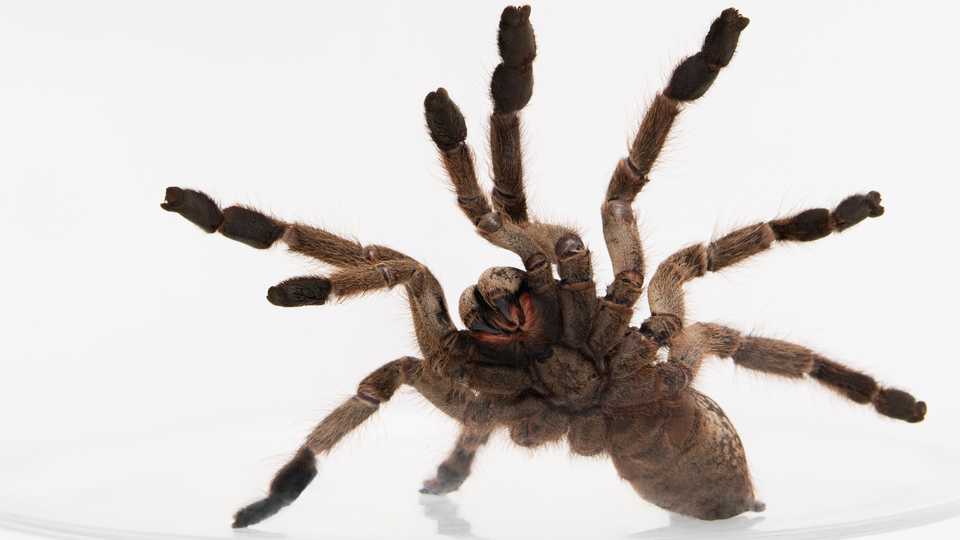Science News
Monday Bites: Bee Hairs, Tarantula Bites, and Choosy Males

Electric Bee Hairs
As we reported in this video several years ago, bees pick up electric signals from flowers, which notify the insects that pollen awaits. But scientists were unsure how the bees detected these signals. Now, a team of researchers, publishing in Proceedings of the National Academy of Sciences, has determined that bee hairs deflect in response to an electric field, alerting the bee’s nervous system. “We were excited to discover that bees’ tiny hairs dance in response to electric fields, like when humans hold a balloon to their hair,” says Gregory Sutton of the University of Bristol. “A lot of insects have similar body hairs, which leads to the possibility that many members the insect world may be equally sensitive to small electric fields.” Electroreception is common in aquatic mammals—for example, sharks have sensitive, jelly-filled receptors that detect fluctuations in electric fields, helping them home in on their prey.
Microplastics and Fish Larvae
It’s no secret that plastics are contaminating our oceans, affecting marine life from sea turtles to birds. But what about microplastics—fragments less than five millimeters in all dimensions that are either manufactured that way or break down from larger pieces of debris? To determine microplastics’ effects, scientists collected European perch embryos and larvae from the Baltic Sea and took them to the lab, exposing them to varying concentrations of polystyrene microplastics. They found exposure of embryos to microplastics decreased hatching success by about 15 percent. In addition, exposure to microplastics decreased growth rates, altered feeding preferences of the larvae, and prevented the fish from responding to predatory cues. The researchers, publishing in Science, hope that studies like this mitigate the entry of microplastics into the oceans by determining the types that may be most hazardous and by identifying the most sensitive populations, species, and ecosystems. “With such data in hand,” they write, “practitioners can shift their energy toward prevention and avoid the need for costly recovery and restoration.”
Tarantulas and Human Pain
We call our weekly column “Monday Bites,” but in this case, we mean it literally… How do we sense pain? Many nerve fibers are involved in sensing pain and they use voltage-gated sodium channels—which form a pore that allows sodium ions to cross the cell wall—to initiate the electrical impulses that signal pain. But the exact pathway isn’t clear. So David Julius, of UC San Francisco, and colleagues investigated how the toxins from the venom of the African tarantula species, Heteroscodra maculata, cause pain in mice. They found that a particular sodium channel subtype, called Nav1.1, was activated by one of the toxins, eliciting pain in the mice, but without any associated inflammation—plus the mice became hypersensitized to touch (mechanical pain) but not heat (thermal pain). This sensitivity to mechanical pain could help researchers find new treatments for central nervous system disorders and the abdominal pain that comes from irritable bowel syndrome.
Males are Choosy, When it’s the Last Choice…
“With over 80 percent of males cannibalized after their first copulation, males need to make their one shot at paternity count,” says Eric Yip of Cornell University. You better believe it! In the orb weaving spiders, Cyrtophora citricola, females often eat the males after mating, so the males tend to be a bit pickier when choosing their mate. Due to the relatively low abundance of eggs compared to sperm, female spiders are usually pickier about their mate, while males attempt to increase their number of offspring by mating promiscuously. But male orb weavers don’t have this option. Yip and his colleagues studied virgin males and females in captivity and found that the males were much more selective than the females. Their findings are published in PLoS ONE. The team believes this translates to the wild, as well. “In a colony, males are likely to encounter multiple receptive females,” he says, “and we found that males prefer to court and mate with younger, fatter, and therefore potentially more fecund females.”
Image: Lucas Foglia